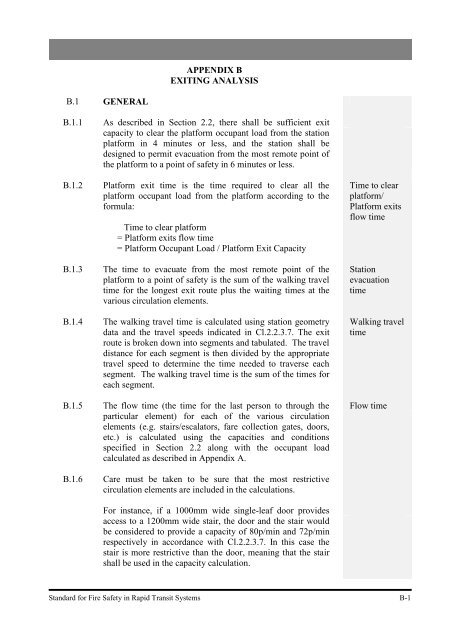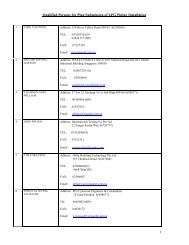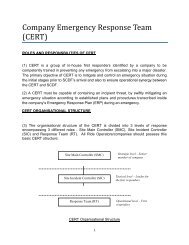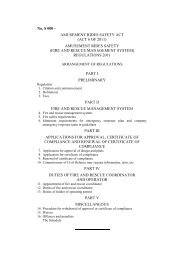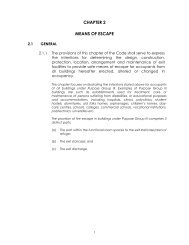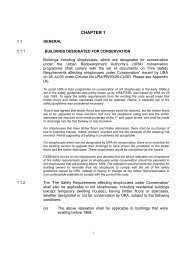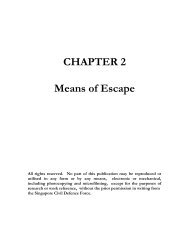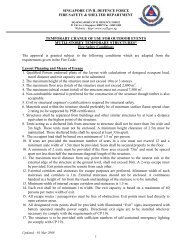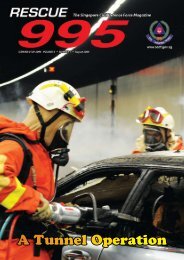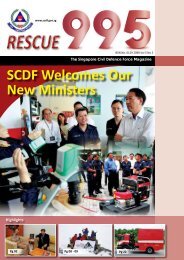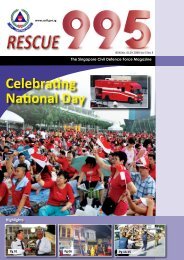Standard for Fire Safety in Rapid Transit Systems - Singapore Civil ...
Standard for Fire Safety in Rapid Transit Systems - Singapore Civil ...
Standard for Fire Safety in Rapid Transit Systems - Singapore Civil ...
You also want an ePaper? Increase the reach of your titles
YUMPU automatically turns print PDFs into web optimized ePapers that Google loves.
B.1 GENERAL<br />
APPENDIX B<br />
EXITING ANALYSIS<br />
B.1.1 As described <strong>in</strong> Section 2.2, there shall be sufficient exit<br />
capacity to clear the plat<strong>for</strong>m occupant load from the station<br />
plat<strong>for</strong>m <strong>in</strong> 4 m<strong>in</strong>utes or less, and the station shall be<br />
designed to permit evacuation from the most remote po<strong>in</strong>t of<br />
the plat<strong>for</strong>m to a po<strong>in</strong>t of safety <strong>in</strong> 6 m<strong>in</strong>utes or less.<br />
B.1.2 Plat<strong>for</strong>m exit time is the time required to clear all the<br />
plat<strong>for</strong>m occupant load from the plat<strong>for</strong>m accord<strong>in</strong>g to the<br />
<strong>for</strong>mula:<br />
Time to clear plat<strong>for</strong>m<br />
= Plat<strong>for</strong>m exits flow time<br />
= Plat<strong>for</strong>m Occupant Load / Plat<strong>for</strong>m Exit Capacity<br />
B.1.3 The time to evacuate from the most remote po<strong>in</strong>t of the<br />
plat<strong>for</strong>m to a po<strong>in</strong>t of safety is the sum of the walk<strong>in</strong>g travel<br />
time <strong>for</strong> the longest exit route plus the wait<strong>in</strong>g times at the<br />
various circulation elements.<br />
B.1.4 The walk<strong>in</strong>g travel time is calculated us<strong>in</strong>g station geometry<br />
data and the travel speeds <strong>in</strong>dicated <strong>in</strong> Cl.2.2.3.7. The exit<br />
route is broken down <strong>in</strong>to segments and tabulated. The travel<br />
distance <strong>for</strong> each segment is then divided by the appropriate<br />
travel speed to determ<strong>in</strong>e the time needed to traverse each<br />
segment. The walk<strong>in</strong>g travel time is the sum of the times <strong>for</strong><br />
each segment.<br />
B.1.5 The flow time (the time <strong>for</strong> the last person to through the<br />
particular element) <strong>for</strong> each of the various circulation<br />
elements (e.g. stairs/escalators, fare collection gates, doors,<br />
etc.) is calculated us<strong>in</strong>g the capacities and conditions<br />
specified <strong>in</strong> Section 2.2 along with the occupant load<br />
calculated as described <strong>in</strong> Appendix A.<br />
B.1.6 Care must be taken to be sure that the most restrictive<br />
circulation elements are <strong>in</strong>cluded <strong>in</strong> the calculations.<br />
For <strong>in</strong>stance, if a 1000mm wide s<strong>in</strong>gle-leaf door provides<br />
access to a 1200mm wide stair, the door and the stair would<br />
be considered to provide a capacity of 80p/m<strong>in</strong> and 72p/m<strong>in</strong><br />
respectively <strong>in</strong> accordance with Cl.2.2.3.7. In this case the<br />
stair is more restrictive than the door, mean<strong>in</strong>g that the stair<br />
shall be used <strong>in</strong> the capacity calculation.<br />
Time to clear<br />
plat<strong>for</strong>m/<br />
Plat<strong>for</strong>m exits<br />
flow time<br />
Station<br />
evacuation<br />
time<br />
Walk<strong>in</strong>g travel<br />
time<br />
Flow time<br />
<strong>Standard</strong> <strong>for</strong> <strong>Fire</strong> <strong>Safety</strong> <strong>in</strong> <strong>Rapid</strong> <strong>Transit</strong> <strong>Systems</strong> B-1


